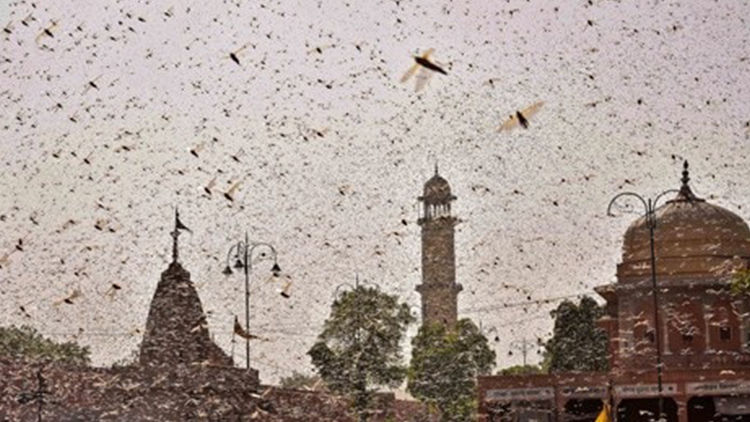While India is already struggling with the effects of the novel Coronavirus on its economy, locust attack or plague can further severely damage its agricultural economy and threaten food production for India. This is the worst attack by locusts in the last three decades. The Locust Warning organization, in Rajasthan, has suggested using drones to sprinkle chemicals to kill the locust.
A swarm of crop-eating locusts has entered India through Pakistan after causing havoc in East Africa, and are now attacking a huge stretch of agricultural fields in Rajasthan, Uttar Pradesh, Maharashtra, and Madhya Pradesh. It also asked farmers in Gujarat and Punjab to be prepared with all preventive measures for the attack.
Take a look at some important and basic questions that answer everything about locusts:
What Is Locust?
The Desert Locust is the species of short-horned grasshoppers (Acridoidea) known to alter their behavior and form swarms of adults or hopper bands (wingless nymphs). The swarms shape can be highly mobile and dense. The scientific name for these is Schistocerca gregaria (Forskal).
Don’t Be Mistaken Between Locust And Grasshopper
Locusts are part of a wide group of insects usually called grasshoppers that have wide jumping hind legs. Locusts are a part of the Acrididae family. Locusts differ from grasshoppers because they can change their behavior and routines and migrate over long distances.
How Dangerous It Is For India?
The Rabi crop has been harvested already, and the Kharif is yet to be planted. The damage occurred to the horticulture and other vegetation. Close to 5,00,000 hectares of crops spread over Rajasthan have been destroyed according to reports. 16 of 52 districts in Gujarat and 17 in Uttar Pradesh also registered an impact.
This year’s locust attacks occurred earlier than normal. Such events are usually recorded in the period from July to October but the low wind pressure that produces cyclones and storms has accelerated the problem.
So you see it is dangerous from every aspect that is economy and environment. According to Agri economist Devinder Sharma, the attack is beyond expectation and there are fears that it may further kill all the shrubs, plants, and trees that fall along its way.
What Preventive Measures Can Be Taken?
Dessert locust swamps are way dense than ever this year it has already damaged major parts of Rajasthan, Madhya Pradesh, Haryana, Gujarat, and Punjab and now heading towards Maharashtra. in such a situation people cannot just fix this by beating ‘thalis’ at the locusts that had settled on walls and trees, hoping to make them move on.
To fix this it has to be Ministry of Agriculture and Farmers Welfare, Department of Agriculture, Cooperation and Farmers Welfare, other ministries (External Affairs, Home Affairs, Defence, Earth Sciences, Civil Aviation and Communications)and stakeholders (e.g. State Governments, Health Department, farmers) are to be involved during such Desert Locust emergency.
89 fire brigades; 47 control vehicles; 120 survey vehicles and 810 tractors have already been deployed by the Government to spray pesticides for successful locust control.
Currently, the primary method of managing Desert Locust swarms and hopper bands are with mainly organophosphate chemicals applied by vehicle-mounted and aerial sprayers in less quantity (referred to as ultra-low volume (ULV) formulation) and to a lesser degree by knapsack and handheld sprays.
Locust doesn’t eat humans but that does not mean they are not dangerous, well they are not attacking humans directly as they are damaging the basic necessity for humans which is food crops.

